The Plantation takes off
Sharyland Utilities’ service territory is Sharyland Plantation, a former 6,000-acre agricultural property that, today, serves upwards of 650 customers, 90% of whom are residential. The property is strategically located in the heart of the Rio Grande Valley, just across the border from Reynosa, Mexico. Development of Sharyland Plantation began in earnest in 1997 with the rise of the maquila industry on the Mexican side, spurred by the development of 16,000 acres immediately adjacent to Sharyland in Reynosa.
Envisioned as the epicenter of light industrial manufacturing, distribution, commercial and residential development for northeastern Mexico and a vibrant port of entry, the combined Mexican and U.S. development will comprise some 22,000 acres when fully built out over the next ten years. Michael Landgraf, Marketing Manager for Dallas-based Hunt Power, L.P., predicts “it’ll be the largest integrated masterplanned international community anywhere.”

Figure 1: Every unit in the nine Sharyland subdivisions will be fitted with automated metering capabilities to identify and reduce demand peaks for energy savings.
As the third fastest-growing city in the country, McAllen was named by Forbes as one of the top five places in America to do business. As expected, the population projected for the Sharyland/Reynosa economic zone has fueled tremendous growth on the U.S. side. Construction of nine separate subdivisions in Sharyland—ranging in price from $80,000 to almost one million dollars per home—is well underway, with growth expected to top 10-12,000 residents by the end of the decade (Figure 1).
So far, only about 25% of the 6000-acre parcel has been developed. Michael Landgraf says that a sustained effort to draw high-tech companies to the area has already borne fruit. Symbol Technology, Bissel and Panasonic, to name a few, were recently joined by Black & Decker. Recognized names in the call center/data center/back office business will soon occupy space in CentraTek’s new 75,000 square foot Sustainable Technology Business Center. Nearing completion now, this first STBC will provide a state-of-the-art, computer-intensive environment for up to 500 people, and a template for future area technology centers.
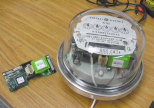
Figure 2: The AMR module shown at left is mounted under the meter disk and provides auto dial capability to send interval load data to UDRI/MeterSmart, the outside data services provider under contract to Sharyland Utilities.
More infrastructure needed
Anticipating the demand that will be placed on the increasingly burdened grid, Sharyland Utilities has spent considerable time and effort developing a master plan that will support the community’s growing infrastructure needs. At this time, the long-range plan calls for a total of four 100MVA substations at key locations, redundant transformers, a loop transmission system, and a host of other implementations. “Being a totally planned development works out really well for the utility,” says Mark Caskey. “It lets us design and build our infrastructure, systematically and efficiently, block by block—without some developer wanting to put service in two miles from our existing lines.”
As a wires company, Sharyland doesn’t sell power but charges the customer’s energy service provider a transmission and distribution fee based, respectively, on that customer’s contribution to Sharyland’s four coincident summer peaks and on the customer’s own monthly noncoincident demand. To the utility, demand reduction means avoided costs that would have otherwise been incurred and passed along to the consumer. “Any amount of demand reduction potentially reduces Sharyland Utilities’ investment in infrastructure and the amount they have to charge for their services,” says Dan Price, Senior VP of Dallas-based MeterSmart, L.P., a Hunt Power subsidiary.
Deregulation spurs demand reduction
On January 1, 2002, deregulation started for most customers in Texas and, as part of that, most wires companies implemented new tariffs that included a demand component for billing their customers. “We’re the only utility,” Mark Caskey claims, “that has the ability to bill all of its customers on actual demand because of our automated meter reading capabilities.”
“Sharyland has a demand rate for all classes of customers,” notes Mark Caskey. “Therefore, any customer who can identify demand reduction can potentially save on his electric bill.” For this reason, Sharyland Utilities is aggressively implementing demand side management (DSM) tools that can supply 100% of its customers with energy monitoring capability viewed through the Internet. Using these tools will give all Sharyland customers equal access to their interval load data upon which their demand, and therefore rate structure, is based. Although the type of interval data is essentially the same for all customers, the collection process differs, at least at this time, for residential vs. commercial/industrial users.
AMR-ready metering for the housing market
The utility provides each house with a standard Form 2S residential kWh meter that also includes an under-the-glass AMR (automatic meter reading) module (Figure 2). The AMR module connects to the utility side of the meter and draws power from the meter’s 240V supply. The module reads the meter disk and provides a corresponding pulse output. The device’s modem board has a built-in telephone interface that connects to the customer’s phone system at the service entrance. Common trenching of all utilities at the residential site makes for quick meter installation and hook up, which typically runs only 7-10 minutes per unit (Figure 3). “We put in 500 meters in one month,” says Billy Echols, who supervised the hook-ups and did many himself. Echols works for MeterSmart but hangs his hat in Sharyland, where he leads the crew that Sharyland Utilities uses for meter installations, connections and repairs.
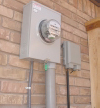
Figure 3: Common utility trenching simplifies installation of phone-based AMR solutions. The AMR module is installed under the meter glass and connected to the phone line at this Sharyland residence.
Mass-storage metering for the business sector
Commercial and industrial facilities also employ common trenches for utilities. But the electrical service entrance, where the meter is located, is outside and some distance from the telephone switch room, which is typically inside the building somewhere. This being the case, a modem-based AMR solution would incur the added expense of running a phone line out to the meter, making it impractical in many cases. Sharyland is currently evaluating wireless interfaces, submetering, and other remedies. In the meantime, solid-state meters with onboard mass memory are used to log the data in 15-minute intervals, and then store it onboard for subsequent download (Figure 4).
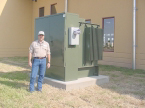
Figure 4: MeterSmart Technician Billy Echols prepares to download 30 days of interval data from the mass storage meter mounted on the side of the padmount transformer outside a Sharyland commercial facility. The data will be e-mailed in HHF format to UDRI/MeterSmart for input into the data processing software system.
Interval data collection
Sharyland contracts with Arlington, Texasbased UDRI/MeterSmart for a number of feebased services including, where appropriate to the class of customer: automatic meter reading, data validation and editing, real-time pricing and billing, load research, data archiving, turnkey load control solutions, on-site technical support, Internet presentation and more. Headquartered some 500 miles to the north, UDRI/MeterSmart was key to Sharyland Utilities’ success from the beginning. (Note: MeterSmart acquired UDRI in June 2001.)
“We’ve provided meter installation and hookup, disconnections and testing services to MeterSmart’s Dan Price. “We originally approached Sharyland with the concept of empowering their customers with tools to make informed energy decisions. It was a natural progression for them,” he says, “since interval data is collected for billing purposes.”
In residential applications, the load data is collected at 60-minute intervals and automatically uploaded every 24 hours to UDRI/MeterSmart, who applies proven validation, editing and estimation (VEE) techniques to ensure a high level of integrity in the data collection process. This process is similar for commercial and industrial customers, except that the load data is downloaded into the meter reader’s laptop computer, converted to hand-held file (HHF) format and then e-mailed to UDRI/MeterSmart for processing.
The metered interval data obtained from each residential and commercial/industrial customer is then used to calculate the customer’s demand profile. The same information is also used by the customer’s energy service provider for billing, and by Sharyland Utilities to compute a portion of the wires charge it levies on each customer’s energy service provider in the form of a Transmission/Distribution Service Provider (TDSP) fee.
Web-based presentation
Mid-February 2002 saw the roll out of a new, non-fee based service for all Sharyland Utilities customers—the ability to view their energy usage information, in both numerical and graphic format, on the Internet. To access it, users simply log on to www.udri.com and click on the “registered users” button, which takes them to a secure data portal requiring their I.D. and password for entry. Requiring neither dedicated workstation, proprietary software nor programming, the information is easily accessible via any Windowscompatible browser (Figure 5).
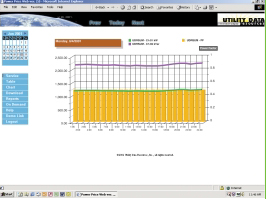
Figure 5: UDRI/MeterSmart operates a password-protected web site where Sharyland residential and commercial/industrial customers can access load profile information.
Additional on-line services will soon join Sharyland’s repertoire on a subscription basis. These include direct-to-the-customer e-mail reports detailing daily, weekly or monthly energy usage; and an energy alarm service that will notify residential and business customers when userdefined maximum energy thresholds have been exceeded. Additional capability, via the Internet, will allow users to update their energy usage “on demand” to the current time of day.
Richard Guerra, Technical Marketing Specialist for MeterSmart, sees interest building among commercial/industrial customers, as well as residential, for web-based information. Driven in part by deregulation, rising energy costs are starting to get everyone’s attention—making the value of the load information that UDRI/MeterSmart provides to the Sharyland Utilities customer even more obvious as time goes on. For the customer who already sees its value, frequent updates, viewed via the Internet, allow problem areas to be identified more quickly and corrective measures applied with minimal delay.
“The goal of all this,” Mark Caskey points out, “is to inform customers as much as possible regarding their energy usage so that they’ll understand their electric bill better, and be motivated to implement energy conservation measures.”
Building energy awareness, one customer at a time
Despite many similarities in the way that load data is processed and presented to the different classes of customers, there is a big difference in how effectively the information is used to shave costs. Many companies, particularly larger energy users, are already onboard with technically sophisticated energy management and conservation programs, made that much more effective by the level of information that Sharyland provides via its outside service partners.
But on the residential side, the current low-awareness level is due mostly to a lack of knowledge, information, opportunity, and often, desire, to alter comfortable energy consumption patterns. “It’s a matter of educating the customer,” says Richard Guerra, “but once they see the value of the information they’re getting, they tend to be more proactive in cutting energy usage in any reasonable way they can.”
Not everyone is interested in studying their energy usage on a daily basis, Guerra maintains. “I mean, let’s face it,” he laughs, “residential load shapes just aren’t that exciting.” Even so, there’s much that can be done to save energy around the house. Customer demand charges are based on the highest hourly usage peak of the month, even if it only occurred once during that billing period. Knowing this should incentivize the concerned consumer to rethink his energy consumption habits.
One solution might be to utilize programmable thermostats to control air conditioning, water heaters as well as other appliances in the home. Not running the clothes dryer, kitchen appliances and other high-energy users at the same time can reduce peak demand considerably. As a result of education and increased awareness, fueled by information access, some users have extended their conservation efforts to installing programmable controls to run sprinklers, swimming pool pumps, outdoor lighting, etc.—as a way to spend their energy dollars “smarter.”
Conclusion
This summer, Sharyland celebrated its third birthday as an electric utility in the state of Texas (Figure 6). In contemplating the road well-traveled, Mark Caskey waxes nostalgic: “I look back at the many challenges we faced along the way, and it seems like it’s been forever. It’s not like working for a ‘traditional’ utility where you have a specific job that you do,” he says. “It’s been a much bigger, more encompassing thing.”
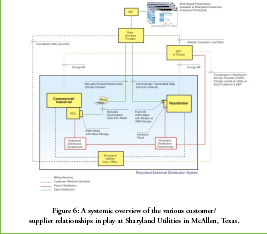
Figure 6: A systemic overview of the various customer/supplier relationships in play at Sharyland Utilities in McAllen, Texas.
Good old-fashioned hard work in both the front office and in the field has put Sharyland Utilities where it is today. The key supplier relationships that Mark Caskey and his small crew have relied on—UDRI/MeterSmart, outsourcing T&D construction, Hunt Power, and others—are as much a part of the Sharyland success story as anything. Few customers realize how lean an operation Sharyland Utilities is running down there in McAllen. In addition to the GM, there is only a T&D Engineer, an accountant, receptionist and office manager. “That’s really our whole staff,” Mark Caskey admits. “We’re as close to a ‘virtual’ utility as you’ll ever run across, but our reliability, service and customer satisfaction are just what you’d expect from a ‘real’ utility—maybe even better.”







